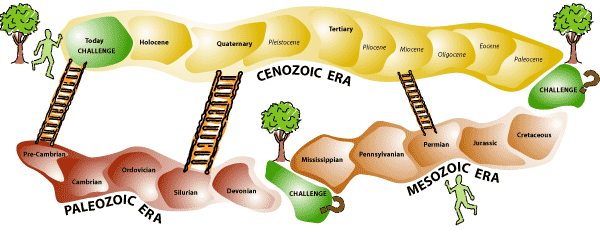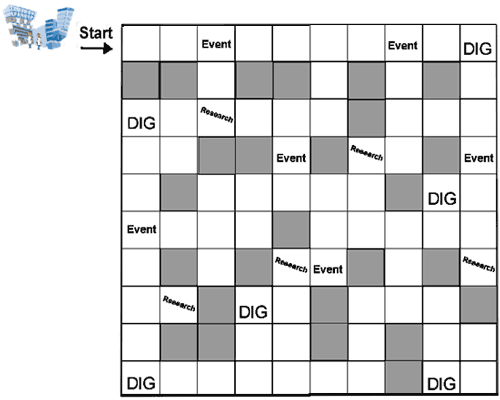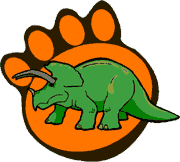|
Instructional Objective | Learners
& Context | Object of Game | Game
Materials |
|
Time Required | Rules | Design
Process | References |
We
developed three different versions of the game further than
we probably should have and have left documentation for the
first two versions here (for the time being) to illustrate
some of the thought processes and evolution of the development.
We submitted a draft
of Alternative C (PDF, Requires Acrobat Reader 6) for
Play Testing. The
final version can be viewed here.
Instructional
Objective
Alternatives
A and B
Learners
will develop a general understanding of the various geological Eras
and Periods coupled with the plants, animals and geologic formations
associated with each era. The action of the game will be loosely based
on the context of paleontological digs.
Alternative
C
Learners
& Context of Use
Who
is the game designed for? Describe them in terms of their age, grade
level, affinity towards the subject matter, and anything special about
them that the reader should know.
Where
would the game be used? If in a school, what accomodations would you
need to make to do it in a typical classroom? Is it designed to be played
more than once? What would happen prior to the game? What would happen
after it?
Alternative
A
The
object of the game is to collect the most valuable combination of Funding
Dollars and Specimen Cards
Alternative
B
Goal
is to collect 5 (or more?) Specimen Cards from the same era and get
back to the start/end space with some money left in their account.
Alternative
C
Go
though the dig site, and find fossil specimens and the information about
them. Players must match up 5 Specimen Cards with their correct Research
Card and be the first to make it back to the University.
Alternatives
A and B
- 6
Playing Pieces
- 6-Sided
Die or Spinner
- ≈20
Challenge Cards
- ≈50
(?) Specimen Cards
- 21
Dig Site Cards
- $1
Million (?) of "Funding Dollars" or "Paleo Dollars"in
denominations of $1,000 to $10,000
- One
Game Board

Alternative
C
-
6 Playing Pieces.. Pieces are Paleo tools. Some typical are: shovels,
brushes, toothbrushes, dental tools, jack hammers, bull dozers,
ground penetrating radar, jeeps, gps mapping tools.
-
6-Sided
Die or Spinner
-
25
Event Cards
-
50
Dig and Corresponding Research Cards
-
One
Game Board.
Alternatives
A and B
The
game may be played on a timed basis of 45-60 minutes or it may be played
until all players but one run out of Funding Dollars or to any point
in between to determine which player has the most valuable combination
of Funding Dollars and Specimen Cards.
Alternative
C
The
game may be played on a timed basis of 45-60 minutes or it may be played
until the first player returns with 5 matched cards. If the game is
timed, at the end of the time limit the player with the most matched
cards wins.
The
Rules
Alternative
A
- 2-6
Players
- Each
player receives $100,000 in Funding Dollars to start the game
- Players
throw die or spin spinner (?) to determine the order of play
- Starting
on the Today space, players throw die/spin (?) to progress around
the board in a clockwise direction, unless directed otherwise by a
Challenge Card. When landing on a space with a ladder, a player may
also choose to skip ahead or back to the space at the other end of
the ladder.
- Upon
landing on a Dig Site, the player may use funding dollars (amount
printed on each Dig Site card) to "start a dig" and become
the Manager at that site if no digs have previously been started there.
- Before
receiving the Dig Site card, the player must correctly answer the
question printed on the front of that Dig Site Card.
- When
landing on any dig site (previously established by other players or
not) any player may contribute $1000 Funding Dollars to the dig and
attempt to obtain Specimen Cards from that Period or Era by answering
the question on the front of each Specimen Card for the Era. The proceeds
go to the Dig Manager if the Site is occupied or to a Kitty if the
site is unmanaged. Any player may keep the Specimen Card earned at
any site if the player correctly answers the question. If the answer
is incorrect, the Specimen Card goes to the player who is the Manager
for that Site or back into the card stack if the site is unmanaged.
- The
Board contains 3(?) Challenge/Opportunity(?) spaces including the
Today starting point space. After the first move, any player landing
on one of those spaces must draw a card from the the stack of Challenge
Cards and follow whatever direction is given. Directions can include
receiving more funding, losing a turn, having an unforeseen expense,
winning a prize from Funding Dollars accrued in the Kitty, etc.
Alternative
B
- Players
receive $25,000 Paleo Dollars to start the game.
- They
move through the board and their goal is to collect ??? Paleo Cards
of animals and plants to win the game. They spin a spinner to move
through the board. Specimen cards are in one pile in the middle of
the board.
- There
are three types of spaces they can land on: Specimen, Paleo Dig (opportunities
and obstacles) and Neutral spaces. They must pay to receive specimen
cards as they land on specimen spaces but they can only get specimen
cards it if they have a permit to dig in that area.
- Players
purchase permits to dig in any area. They spin the spinner to see
how much a permit costs. Permits cost $1,000 times the number on the
spinner.
- To receive
a specimen card they also spin the spinner and pay $100 times the
number on the spinner for that card. (Could also have $$ values on
each card and they must pay that amount to earn the card.) Cards have
name of animal or plant, era they existed in and a value to keep the
card. If a player does not want to purchase the card the card goes
to the bottom of the stack.
- When
they land on a Paleo Dig space they take a Paleo Dig card. These direct
them to receive more money, give up cards, lose a turn, pay for repairs,
etc. Some spaces have directions on them or have inherent rewards.
The start space is a funding source and every time they pass it they
receive an additional year of funding, $10,000. Other direction spaces
???
Alternative
C
- Players
start at their University.
- Each
player rolls the die to move.
- Players
move the number of spaces indicated on the die and can
take any route they want. (Since each space is a grid,
players can move in one of 4 directions-up, down, right
and left. They cannot rule diagonally.) Players must go
around any space another player occupies and cannot
move through or occupy any grey squares
- As
players move around the board and they land on a Dig or
Research space they take an appropriate card. They can
not take two Dig or Research cards in a row from the same
space so they must move to another Dig or Research space
for their next card.
- If a
player lands on an Event square they must draw an event
card and follow the directions on the back of the card.
- The
goal is to match the correct Dig card with its matching
Research Card.
- When
they get 5 matching cards (or when the game ends) they
maneuver back to the University.
- First
one back to the University wins the game.
Design
Process
We
started the process by trying to create a game to go with a Paleontology
video we were developing for another project. We wanted to create a
game that would help players associate plants and animals with the type
of landscapes and geological formations found in ancient time periods.
We also wanted to create a game that would give players a sense of some
of the issues involved in a paleo dig.
We
reviewed Cardboard
Cognition, searched the Internet and went to a few teacher stores
and game stores looking for similar games. (This is still in process.)
We were also referred to archeology game and activity sites. We found
one game (Dig) that was a paleontology game focused on teaching dinosaur
facts.
We
wanted to make this game encompass more than dinosaurs and wanted to
help students make inferences and connections rather than merely teach
facts. We worked through the game design process (http://edweb.sdsu.edu/Courses/EDTEC670/boardgame/BoardGameDesign1.html)
individually and then compared notes. We reworked the concept several
times, and reworked the board design to align the structure of the game
with the content we wanted to convey.
We
showed this idea to friends, family and Professor Bernie Dodge for feedback.
Bernie's feedback made us go back to the drawing board to redesign the
board and rework the rules.
We
learned how hard it is to create a board game that aligns content with
the structure of the game. We also learned to be more flexible at the
beginning of the game design process so we don't paint ourselves into
a corner. In addition our future games will probably not have as much
content as this one. We discovered how hard it is to research for content
and then place the content on game cards.
Books
& Journals
- Parker, S.
& Bernor R.L. The Practical Paleontologist. (1990). Simon and
Schuster, Inc.
- Wexo, J. B.
(1989). Prehistoric Zoobooks. San Diego, Wildlife Education.
Electronic
Electronic
- American
Museum of Natural History, timeline and website, http://www.amnh.org/exhibitions/Fossil_Halls/Timelines/permian.html
- Paleos
Website, retrieved September 29, 2003. http://www.palaeos.com
- Doug
Henderson Website, retrieved September 29, 2003. http://gallery.in-tch.com/~earthhistory/geologic%20timepage.html
- Smithsonian
Timeline, retrieved September 30, 2003. http://www.nmnh.si.edu/paleo/dino/timescal.htm
- Dinosauricon.com,
retrieved October 1, 2003. http://dinosauricon.com/links/index.html
- San
Diego Museum of Natural History, retrieved October 1, 2003. http://www.sdnhm.org/fieldguide/fossils/timeline.html
- Australia's
Lost Kingdom, retrieved October 1, 2003. http://www.lostkingdoms.com/facts/factsheet48.htm
- Pressroom.com,
retrieved October2, 2003. http://www.pressroom.com/~cromag/PALEOTERMS.htm#sectP
- EnchantedLearning.com,
retieved October 5, 2003. http://www.enchantedlearning.com/subjects/dinosaurs/glossary/index.shtml
|


